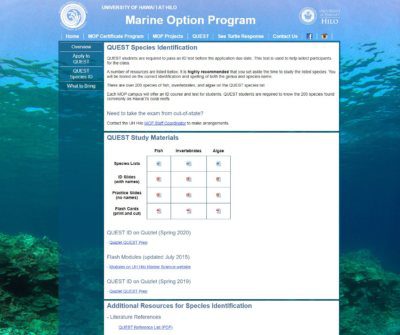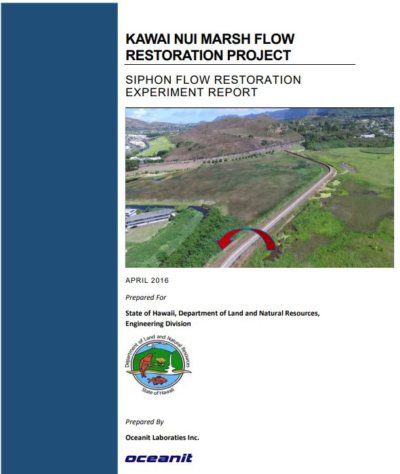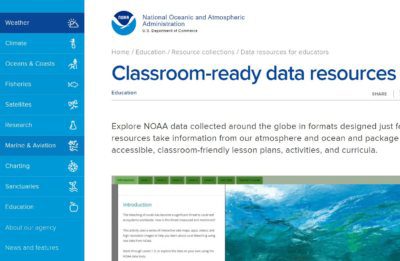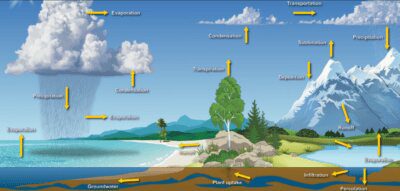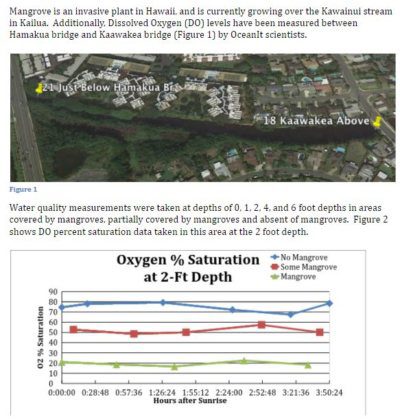The paths and influences of water through Earth’s ecosystems are extremely complex and not completely understood. NOAA is striving to expand understanding of the water cycle at global to local scales to improve our ability to forecast weather, climate, water resources, and ecosystem health. Learn More.
 Water Quality Parameters
Water Quality Parameters
SALINITY:
What does salinity have to do with water quality?
Salinity measurements give a good indication of the source of the water. The average ocean salinity is 35, and freshwater salinity is usually less than 0.5. Salinity values below 35 near the coast can be due to fresh water outflow and storm drainage. Storm water often picks up debris, dirt, and other pollutants and flows through the waterways directly to the ocean. An example of this is the Ala Wai Canal is Honolulu that drains the watershed encompassing Manoa and Palolo Valleys and empties into the Pacific Ocean in Waikiki.
TEMPERATURE:
What does temperature have to do with water quality?
Temperature impacts both the chemical and biological characteristics of surface water. It affects the dissolved oxygen level in the water, photosynthesis of aquatic plants, metabolic rates of aquatic organisms, and the sensitivity of these organisms to pollution, parasites and disease. Temperature also has an effect on the comfort level of recreational water users.
What are typical temperature ranges for Hawai‘i?
Surface water temperatures in Hawai‘i have a relatively small annual range, the lowest temperatures occur in late February to March and the highest are usually in late August to September. The average surface water temperature around O‘ahu is 75°F (24°C) in winter and 81°F (27°C) in summer.
CHLOROPHYLL:
What does chlorophyll have to do with water quality?
High concentrations of the plant pigment “chlorophyll a” in coastal waters are an indicator of nutrient inputs because nutrients fuel the growth of phytoplankton. Chlorophyll a is the most commonly used parameter for monitoring phytoplankton biomass and nutrient status, as an index of water quality because large nutrient inputs can come from either storm runoff or sewage spills.
TURBIDITY:
What does turbidity have to do with water quality?
Turbidity is a measure of water clarity. It tells scientists the degree to which light entering a column of water is scattered by suspended solids. Suspended solids include things such as mud, algae, plant/animal material and, when there are sewage spills, fecal material. Factors contributing to water turbidity include soil erosion, when there are sewage spills, elevated nutrient inputs, and waste discharge.
OXYGEN:
What does dissolved oxygen have to do with water quality?
Like terrestrial animals, fish and other aquatic organisms need oxygen to live. Low dissolved oxygen levels leave aquatic organisms in a weakened physical state and more susceptible to disease, parasites, and other pollutants. Oxygen levels can be reduced when run-off containing phosphate and nitrate (the ingredients in fertilizers) enters coastal waters and causes algal blooms because the algae die when the nutrients are used up and then decay, a process that consumes oxygen. A normal level of algae, however, contributes to elevated oxygen through photosynthesis, just like land plants add oxygen to our air during the day. As dissolved oxygen levels in water drop below 3.0 mg/l, aquatic life is put under stress – the lower the concentration, the greater the stress.
WATER PRESSURE:
What does water pressure have to do with water quality?
Water pressure is an indicator of water depth, or a measure of distance from the ocean surface down to the ocean floor. In the coastal waters of Hawai‘i, changes in depth occur because of the tides. Tides are bulges of water in the ocean caused by the gravity of the sun and the moon. In some coastal areas (e.g. near estuaries), tides can re-suspend sediment, causing the water to become more turbid.
|
|

PacIOOS Water Quality PlatformsPacIOOS has a network of cabled platforms, autonomous underwater vehicles, and coastal moorings deployed in Hawai‘i and cabled platforms in each of the PacIOOS jurisdictions. These instruments measure a variety of water quality parameters including: temperature, salinity, pressure, chlorophyll florescence, turbidity, pH, dissolved oxygen, and carbon dioxide. The PacIOOS water quality platforms in Hawaii, American Samoa, and Saipan report data in near-real-time, the other water quality platforms provide data that are downloaded monthly. Archival data is available for all sensors online. The information collected at these sites is important for agencies, planners, mariners, professional and recreational water users, and the general public.

